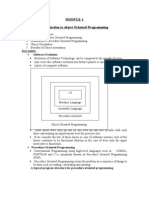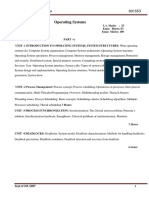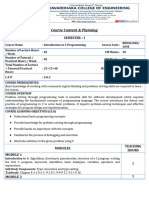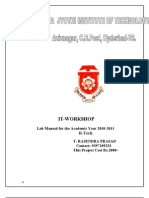Object-Oriented Programming Paradigm
Uploaded by
AnganaObject-Oriented Programming Paradigm
Uploaded by
AnganaObject-oriented programming paradigm
➢ OOP is the most popular programming paradigm because of its unique advantages like
the modularity of the code and the ability to directly associate real-world business
problems in terms of code.
➢ The key characteristics of object-oriented programming include Class, Abstraction,
Encapsulation, Inheritance and Polymorphism.
➢ A class is a template or blueprint from which objects are created.
Objects are instances of classes. Objects have attributes/states and methods/behaviors.
Attributes are data associated with the object while methods are actions/functions that the object
can perform.
Abstraction separates the interface from implementation. Encapsulation is the process of hiding
the internal implementation of an object.
Inheritance enables hierarchical relationships to be represented and refined. Polymorphism
allows objects of different types to receive the same message and respond in different ways.
To illustrate, let's find the sum of first ten natural numbers in the object-oriented paradigm
approach.
Example in Java:
public class Main
{
public static void main(String[] args) {
Addition obj = new Addition();
obj.num = 10;
int answer = obj.addValues();
System.out.println("The sum is = "+answer); //prints-> The sum is 55
}
}
class Addition {
int sum =0;
int num =0;
int addValues(){
for(int i=1; i<=num;i++){
sum += i;
}
return sum;
}
}
➢ We have a class Addition that has two states, sum and num which are initialized to zero.
We also have a method addValues() which returns the sum of num numbers.
➢ In the Main class, we've created an object, obj of Addition class. Then, we've initialized
the num to 10 and we've called addValues() method to get the sum.
Languages that support the object-oriented paradigm:
• Python
• Ruby
• Java
• C++
• Smalltalk
Why should you consider learning the object-oriented programming paradigm?
• Reuse of code through Inheritance.
• Flexibility through Polymorphism.
• High security with the use of data hiding (Encapsulation) and Abstraction mechanisms.
• Improved software development productivity: An object-oriented programmer can stitch
new software objects to make completely new programs (The Saylor Foundation, n.d.).
• Faster development: Reuse enables faster development (The Saylor Foundation, n.d.).
• Lower cost of development: The reuse of software also lowers the cost of development.
Typically, more effort is put into the object-oriented analysis and design (OOAD), which
lowers the overall cost of development (The Saylor Foundation, n.d.).
• Higher-quality software: Faster development of software and lower cost of development
allows more time and resources to be used in the verification of the software. Object-
oriented programming tends to result in higher-quality software (The Saylor Foundation,
n.d.).
You might also like
- Cse-V-Operating Systems (10CS53) - Notes PDFNo ratings yetCse-V-Operating Systems (10CS53) - Notes PDF150 pages
- Lab Manual: Sri Ramakrishna Institute of TechnologyNo ratings yetLab Manual: Sri Ramakrishna Institute of Technology49 pages
- 3cs4-07 Software Engineering Unit - 1 Notes100% (2)3cs4-07 Software Engineering Unit - 1 Notes30 pages
- Object Oriented Programming CS504D SyllabusNo ratings yetObject Oriented Programming CS504D Syllabus2 pages
- Cse-IV-unix and Shell Programming (10cs44) - Notes100% (1)Cse-IV-unix and Shell Programming (10cs44) - Notes163 pages
- Jerusalem College of Engineering: ACADEMIC YEAR 2021 - 2022No ratings yetJerusalem College of Engineering: ACADEMIC YEAR 2021 - 202240 pages
- Cs8582-Object Oriented Analysisand Design Laboratory-46023968-Cs8582 - Ooad LabNo ratings yetCs8582-Object Oriented Analysisand Design Laboratory-46023968-Cs8582 - Ooad Lab132 pages
- Cse-IV-unix and Shell Programming (10cs44) - NotesNo ratings yetCse-IV-unix and Shell Programming (10cs44) - Notes161 pages
- Data Structures Design - AD3251 - Important Questions with Answer - Unit 1 - Abstract Data TypesNo ratings yetData Structures Design - AD3251 - Important Questions with Answer - Unit 1 - Abstract Data Types15 pages
- HNDIT1211 Data Structures and AlgorithmsNo ratings yetHNDIT1211 Data Structures and Algorithms4 pages
- Epson Sample Programming Placement Paper Level1No ratings yetEpson Sample Programming Placement Paper Level19 pages
- BIJASA BSGEODENG-1201 CpE-401 Exercise#4No ratings yetBIJASA BSGEODENG-1201 CpE-401 Exercise#429 pages
- 15CS45 OOC Solutions - Dec 2017 - Jan 2018No ratings yet15CS45 OOC Solutions - Dec 2017 - Jan 201820 pages
- Hashmap - Word Counter Application: Public Class Wordfrequency Implements Comparable (No ratings yetHashmap - Word Counter Application: Public Class Wordfrequency Implements Comparable (4 pages
- Sameer Sir Classes, Jabalpur Auth Exam Center Oracle, Microsoft 9407077858No ratings yetSameer Sir Classes, Jabalpur Auth Exam Center Oracle, Microsoft 940707785814 pages
- Q1. What Is The Difference Between An Abstract Class and Interface?No ratings yetQ1. What Is The Difference Between An Abstract Class and Interface?13 pages
- Figaro: An Object-Oriented Probabilistic Programming LanguageNo ratings yetFigaro: An Object-Oriented Probabilistic Programming Language9 pages

























































































